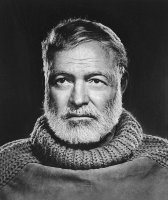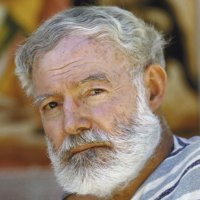 Ernest Miller Hemingway was born July 21, 1899 in Oak Park, Illinois (USA) in the family of a doctor.
Ernest Miller Hemingway was born July 21, 1899 in Oak Park, Illinois (USA) in the family of a doctor.
In 1928 the writer's father committed suicide. Ernest, the oldest son of six children, attended several Oak Park schools and wrote stories and poems for the school newspapers.
After graduation, he worked as a correspondent for the Kansas Star newspaper from 1917 to 1918.
Because of an eye injury sustained in his adolescence, he was not drafted into the army to fight in World War I. He volunteered for service in warring Europe and became a chauffeur for the American Red Cross on the Italian-Austrian front. In July 1918, he was seriously wounded in the leg while trying to carry a wounded Italian soldier off the battlefield. Hemingway was twice awarded Italian orders for his military valor.
After being transferred to the reserve, he was treated in Michigan, then went to Europe, traveled extensively, and wrote articles for the Toronto Star.
In Paris he met American writers Gertrude Stein, Ezra Pound, Scott Fitzgerald and began to write on the principle "the main thing is to compose one sentence of truth, and the rest will follow. Hemingway's first books were published in Paris - Three Stories and Ten Poems (1923) and a collection of stories In Our Time (1924).
Hemingway's first literary success came in 1926 with the publication of his novel And the Sun Rises (Fiesta) about the French and Spanish repatriates of the 1920s, in which the writer expressed the mindset of the "lost generation. The novel was favorably received by critics and gave Hemingway a solid reputation as a promising young writer.
After the publication of another collection of short stories, Men Without Women (1927), he returned to the United States and, settling in Florida in Key West, completed his second novel, Goodbye, Guns, which was a huge success with both critics and the general public.
In the 1930s there was some decline in the writer's work. He spent most of his time on safaris in Africa, bullfighting in Spain, and fishing in the American state of Florida, which affected his writing. Major works of this period include the Spanish bullfight story "Death in the Afternoon" (1932), the writer's first safari diary "The Green Hills of Africa" (1935), the novella "To Have and Have Not" (1937
In 1937, during the Spanish Civil War (1936-1939), having raised money for the Republicans, the writer went to the front as a war correspondent for the North American Newspaper Association and scriptwriter of the documentary film Land of Spain, which was filmed by the Dutch director Joris Ivens.
 Hemingway's long stay in the country resulted in his only major play, The Fifth Column (1938), set in besieged Madrid, and his novel For Whom the Bell Tolls (1940), about the last three days of an American volunteer who gave his life for the republic.
Hemingway's long stay in the country resulted in his only major play, The Fifth Column (1938), set in besieged Madrid, and his novel For Whom the Bell Tolls (1940), about the last three days of an American volunteer who gave his life for the republic.
In the 1940s he bought a house near Havana, Cuba, and traveled to China, where the Japan-China War was going on at the time.
Hemingway took part in World War II. As a war correspondent participated in the British Air Force flights, describing the landing of the Allies in Normandy, in August 1944 entered with American troops in Paris. He was awarded the Bronze Star for his bravery.
In 1950 his novel Across the River, in the Shadow of the Trees, about an elderly American colonel in Venice, was published, which was received coldly by critics.
In 1952 Life magazine published Hemingway's The Old Man and the Sea, a lyrical tale of an old fisherman who caught and then lost the biggest fish of his life. The story was a huge success with both the critics and the general reader, caused a worldwide resonance. For this work the writer received the Pulitzer Prize in 1953, and in 1954 he was awarded the Nobel Prize for literature.
In 1960, Hemingway, diagnosed with depression and severe mental illness, was hospitalized at the Mayo Clinic in Rochester, Minnesota. On leaving the hospital and convinced that he was no longer able to write, he returned to his home in Ketchum, Idaho.
On June 2, 1961, Ernest Hemingway killed himself with a shotgun blast.
Some of the writer's works, such as The Feast That's Always With You (1964) and Islands in the Ocean (1970), were published posthumously.
The writer was married four times. His first wife was Elizabeth Hadley Richardson, his second was his wife's friend Pauline Pfeiffer. Hemingway's third wife was journalist Martha Gellhorn; his fourth was journalist Mary Welsh. From his first two marriages the writer had three sons.


